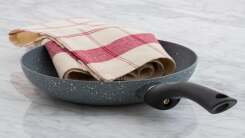Save These Kitchen Scraps for Better Spaghetti Sauce
A lot of people talk about saving veggie scraps for stock (as they should), but too many sleep on the sauce scrap bag. Functionally, the process is similar: Gather your vegetable peels, butts, and other assorted ephemera and put them in a freezer bag; put the bag in the freezer; retrieve it the next time you make stock and use those scraps to flavor a pot of simmering liquid. The process for starting a sauce scrap bag is similar, but the difference is one of focus.
A stock scrap bag can contain anything and everything—there isn’t a veggie scrap around that doesn’t belong—but a sauce scrap bag is slightly more curated. If the vegetable, herb, or shellfish you’re working with is something that would taste good in spaghetti sauce, grab its corresponding peel, stem, or shell and toss it in a freezer bag, and toss that bag in the freezer until the next time you make sauce.
What to add to a spaghetti sauce scrap bag
What you put in your sauce scrap bag is a personal choice, and I wouldn’t dare to dictate its contents. But I do have some suggestions. (And after last week, I’m overdue at giving you suggestions.)

Onion butts and peels. Rinse any dirt off the root end before storing, and be sure to snag any peels with a little onion flesh on them. Simmer with your sauce for an allium-y boost.
Carrot butts. These babies add a hint of sweetness; they’re particularly fantastic in a bolognese.
Shrimp shells. Do you want umami? Because these boys bring the umami. Think of them like anchovies or shrimp paste—slightly fishy, with a deep savoriness. (Just don’t eat them like anchovies; that would be unpleasant.)
Garlic skins. Ditch the outer papery layer and focus on the sticky peels you pull directly off the clove. They’re particularly nice in a simple marinara, especially if you just want a hint of complementary garlic flavor.
Herb stems. Basil and parsley stems have almost as much flavor to offer as their leaves. Tie ‘em up with a little kitchen twine and toss ‘em in.
Parmesan rinds. The hard, waxy rind from your favorite spaghetti garnish packs a salty, creamy, glutamate-heavy punch as it melts into your marinara or Sunday gravy.
Unlike stock or soup, tomato sauce can not be strained to remove your scraps. Instead of wasting time fishing shells, stems, and peels out of your sauce, secure everything together with kitchen twine or tie them up in some cheese cloth before submerging in a mixture of tomatoes, olive oil, and wine. (The cheese cloth will get quite goopy, but I think that’s a reasonable sacrifice.)









Comments on "Save These Kitchen Scraps for Better Spaghetti Sauce" :